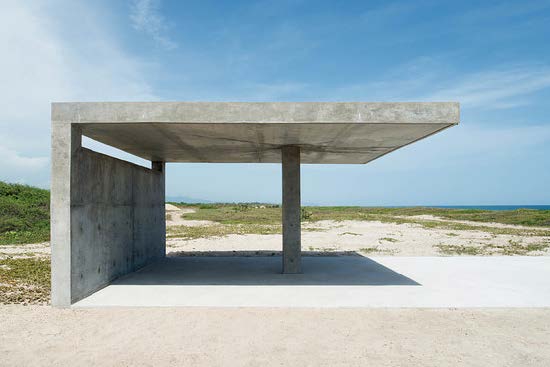I meet the artist Bosco Sodi at Blain|Southern Gallery, in London’s leafy Hanover Square, on a bright and crisp spring morning. I’ve come to discuss his current – and first – solo show in the capital, ‘Yūgen’, which displays a range of his latest painting and sculpture. Originally from Mexico, but currently based in Brooklyn, he maintains studios across the world, including in Barcelona and Berlin, as well as the philanthropic foundation Casa Wabi in his native Mexico. ‘Yūgen is a Japanese word,’ he explains, when I ask about the title of the exhibition. ‘It’s a phrase to describe amazing and overpowering beauty – the profound mystery and temporality of the universe.’ With a focus on natural materials, expressive and serendipitous creation, and vibrant pigments, from hot pink to azure blues, the blend of Japanese philosophy with the colours of Mexico is wildly apparent.

‘Bosco Sodi: Yūgen’ (2016), Installation View. Courtesy the artist and Blain|Southern; Photo: Peter Mallet
‘With this exhibition, I wanted the viewer to feel like they’d entered a cave,’ Sodi continues, in fast and accented English. ‘We painted the walls deep purple because I wanted you to feel like you’d entered a mine with amazing stones and cracking walls.’ The effect is enveloping, and strangely royal in its colour scheme. Around the walls are seven of his large-scale, abstract canvases, each in rich silver with blue-green glitter accentuating the deep crevices that mark their visage. Scattered across the main floor space are tens of glinting, precious-looking golden volcanic boulders. The scattering of stones is similar to the organised scheme of a Japanese Karesansui, or rock garden, which uses carefully placed stones to mimic a natural landscape.

‘Bosco Sodi: Yūgen’ (2016), Installation View. Courtesy the artist and Blain|Southern; Photo: Peter Mallet
I step closer to inspect the surface of one of his large-scale silver canvases. Sodi never names his works, so as not to influence the viewer’s interpretation. I mention that its surface reminds me of the cracked, dry earth of an African savannah, and he nods. ‘We are living in a time that, as a viewer, we feel stupid,’ he muses. ‘The art is so complicated and pretentious, and you have to wait for the master of the universe to unlock its meaning. I am the complete opposite of that. I take my kids very often to see shows, and I’m very honest with them. I say don’t read the press release, if you like it you like it, if you don’t you don’t. I think art should be that way.’
Another driving force behind Sodi’s work is the Japanese philosophical concept wabi-sabi, a teaching that embraces impermanence, accident and imperfection. In his practice, Sodi focuses on the process of creation, instead of the output, which is, for him, therapeutic, ritualistic and alchemical. ‘Wabi-sabi is the philosophy upon which I base my whole work. It’s about embracing the accident, embracing the non-control, embracing the passing of time and working with organic materials.’ In order to achieve his sculptural, enveloping, textural colour, he travels frequently, finding pigments in places as far and wide as markets in India, to specialists in Japan. He then mixes the pigment with glue, sawdust, natural components such as the seeds of the Jacaranda tree from Mexico, and water, which he then applies to the canvas with his bare hands. ‘My approach to painting takes about seven days, but as soon as I see the first crack I stop,’ he explains.

‘Bosco Sodi: Yūgen’ (2016), Installation View. Courtesy the artist and Blain|Southern; Photo: Peter Mallet
The focus on process is also apparent in the 32 volcanic rock sculptures that litter the centre of the gallery floor. Ranging from huge, 800 kilogram boulders to tiny, fragmentary stones, each has been cast in a bright, shimmering 18-carat gold shell. ‘I like to take the organic form that has been created by centuries and centuries of climate change, and to glaze it with gold, making it into an object of desire, a precious object. Each rock is like it’s own universe,’ he says. Every one has been lifted by hand from the Ceboruco volcano near Guadalajara in Mexico, encased in glaze, and fired for three days at 1,260 degrees, meaning very few survive. Sourcing the rocks is a strenuous physical activity. ‘I take 10 guys with me to the volcano, and we choose a rock then pull it out with ropes. For the workers it’s the best day – we drink beer and make fried chicken.’ This joy in the process of creation is for Sodi the key aspect of the sculptures: ‘They now know my taste, they are fully part of the process.’

Casa Wabi, Bosco Sodi’s arts foundation, is located in Oaxaca, Mexico, and was designed by Japanese architect Tadao Ando
And, this approach, which fosters the beauty of serendipity and accident, is perhaps best summed up in Sodi’s most impressive work of art to date – Casa Wabi foundation, a philanthropic complex in Mexico that acts as a community centre, supporting the locals, as well as a free space for artists to practice their work. Designed by Japanese architect Tadao Ando, it’s full of Sodi’s huge clay cube sculptures, and meshes the Japanese philosophy with the Mexican way of life. ‘I think the only way to get things back on track is to embrace beauty, nature and friendship,’ he says. ‘For me it’s about the process and research, and embracing the accident that comes from experimentation.’
‘Bosco Sodi: YŪGEN’ is at Blain|Southern Gallery, London, until 12 June. Click here for more information on the Casa Wabi Foundation.
Unlimited access from just $16 every 3 months
Subscribe to get unlimited and exclusive access to the top art stories, interviews and exhibition reviews.














![Masterpiece [Re]discovery 2022. Photo: Ben Fisher Photography, courtesy of Masterpiece London](http://www.apollo-magazine.com/wp-content/uploads/2022/07/MPL2022_4263.jpg)
It’s time for the government of London to return to its rightful home